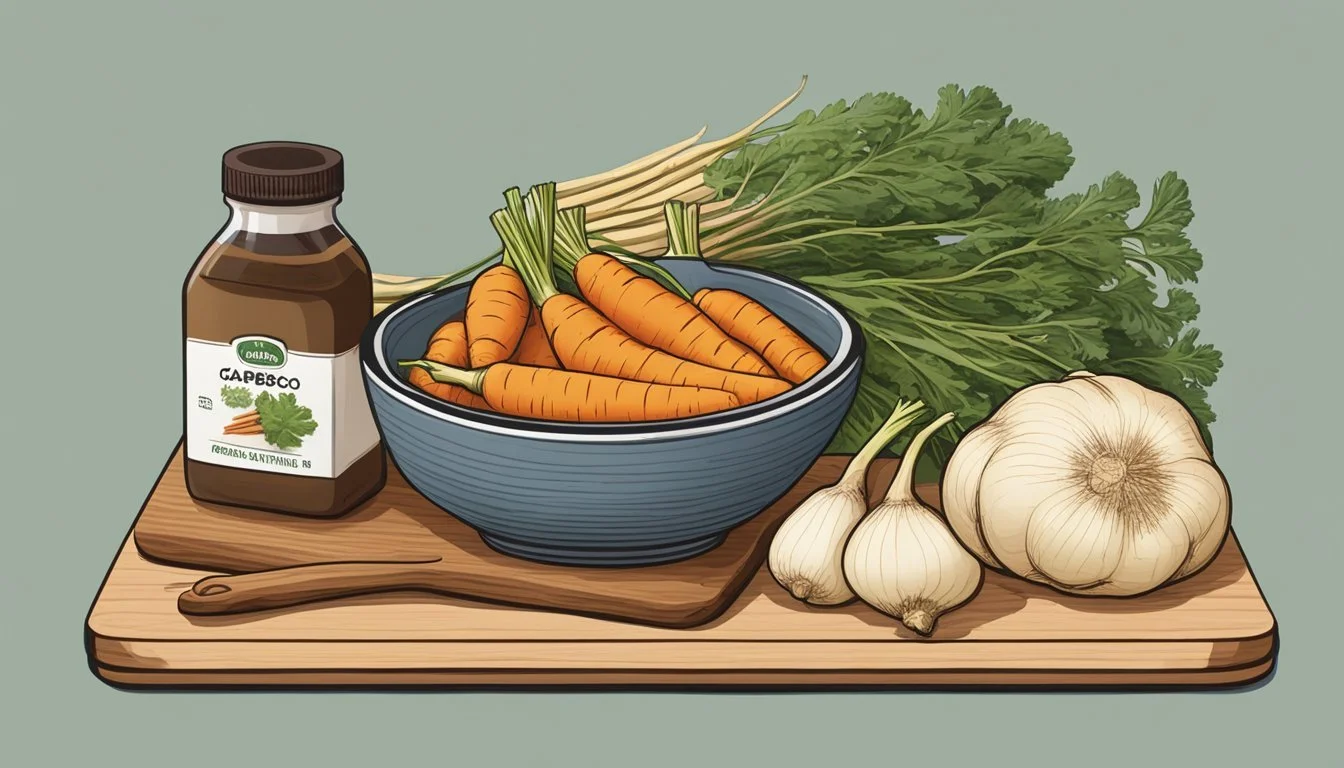Gobo Root Substitutes
Top Alternatives for Your Recipes
For those in search of gobo root substitutes, it can be quite a challenge given its unique flavor and texture. Gobo root, also known as burdock root, is a staple in Japanese cooking, appreciated for its earthy taste and crunchy texture. A highly recommended substitute for gobo root is salsify, which shares a similar texture and can effectively replicate the experience in many dishes.
Other viable substitutes include lotus root, chicory, parsnips, potatoes, radishes, and carrots. Each of these alternatives brings its own distinct qualities to a recipe, but most manage to maintain the integrity of dishes traditionally prepared with gobo root. For herbal tea enthusiasts, dandelion tea stands out as an excellent replacement for burdock root tea.
By experimenting with these substitutes, you can continue to enjoy the delightful flavors of gobo root dishes even when the original ingredient isn't available.
Understanding Gobo Root
Gobo, known as burdock root, is a versatile ingredient in Japanese cuisine with rich nutritional benefits and a distinct flavor profile. This root vegetable offers numerous health benefits, including dietary fiber and essential vitamins, making it an important component of many traditional dishes.
Origin and Cultivation
Gobo originates from East Asia, with significant cultivation in Japan. It is called 牛蒡 (burdock) in Japanese. The plant thrives in temperate climates and is typically grown for its long, slender root. Farmers harvest the root in the fall when it is most tender and flavorful. Careful cleaning and peeling are essential to preserve its delicate taste, often involving thinly peeling the skin and scrubbing away any residual earth.
Nutritional Profile
Burdock root is packed with essential nutrients and antioxidants. It is an excellent source of dietary fiber, which aids digestion and promotes a healthy gut. The root is rich in vitamins such as B6 and E, and minerals like potassium, which support various bodily functions. Its antioxidant properties help combat free radicals in the body, contributing to its health benefits. Including gobo in the diet can enhance overall wellness due to its nutrient-dense composition.
Culinary Uses
In Japanese cuisine, gobo is a staple ingredient known for its earthy flavor and crunchy texture. It is often used in traditional dishes like kinpira gobo, a stir-fried dish with soy sauce, mirin, and sesame seeds. Gobo can be boiled, pickled, or even used in soups and stews. Its versatility extends to herbal teas, where it is appreciated for its mild taste and health benefits. This root is celebrated for adding depth and nutrition to various Japanese meals, solidifying its place in the culinary arts.
Gobo Root Substitutes
Finding substitutes for gobo root, also known as burdock root, can help maintain the texture and flavor of recipes. Key alternatives include other root vegetables and specific plant parts that offer similar characteristics.
Common Substitutes and Their Uses
Salsify is one of the best alternatives for gobo root. It has a similar texture and can be included in soups, stews, and stir-fries.
Lotus root offers a mild flavor and crunchy texture. It's ideal for recipes that call for julienned gobo root.
Carrot and parsnip are also effective substitutes, providing sweetness and a slightly crunchy texture. These can be used in both raw and cooked dishes.
Chicory root provides a distinct earthy flavor and crunch, suitable for soups and stews.
Daikon can substitute for gobo root in salads and simple braised dishes, offering a mild taste.
Radish and potato, while different in flavor, can mimic the texture of gobo root in some recipes.
Adapting Recipes with Substitutes
When substituting gobo root, it’s important to consider the recipe’s flavor profile. For example, using lotus root in a miso soup may require adjustments in soy sauce and sugar to balance flavors.
In recipes calling for julienned gobo root, such as kinpira gobo, carrots can provide a similar texture. Combine with seasonings like soy sauce and sugar to reach the desired taste.
For herbal teas, dandelion tea can replace burdock tea, maintaining its health benefits.
Choose substitutes that best match the texture and flavor required. For example, parsnips may be more suited for hearty stews, while chicory root works well in dishes needing a slightly bitter edge.
Health and Dietary Considerations
Burdock root substitutes offer a range of health benefits and can fit well into various dietary plans. Key considerations include their medicinal properties and their roles in different diets.
Medicinal Properties
Many burdock root substitutes, like dandelion root, are valued for their potential health-promoting properties. Dandelion root, often used in teas, acts as a natural diuretic. This can help reduce water retention and promote kidney function.
Salsify, another substitute, contains inulin, a fiber that supports gut health by promoting beneficial bacteria. Both lotus root and salsify are considered beneficial for managing inflammation due to their antioxidant content.
These substitutes often classify as superfoods and are used in supplements for various health benefits such as providing calcium, aiding digestion, and improving skin health.
Dietary Applications
In vegan and vegetarian diets, burdock root substitutes like carrots and radishes are frequently used in bento lunch boxes for their crunchy texture. These substitutes are versatile and can be included in soups, stews, and salads.
Lotus root and salsify can be thinly sliced and added to stir-fries, offering a mild flavor and a satisfying crunch. When seeking a potato alternative, options like salsify and parsnips provide similar textures with added health benefits.
Herbal teas made from dandelion root are popular for their earthy flavor and digestive benefits. Such substitutes can enrich the diet with essential vitamins and minerals, making them integral to a health-conscious lifestyle.
Sourcing and Storage
When looking for gobo root and its alternatives, one can turn to several reliable sources and methods. Proper storage is crucial to maintain its freshness and flavor.
Finding Gobo Root and Substitutes
Gobo root, also known as burdock root, can be commonly found in Asian markets. These specialized stores often carry fresh produce that is not typically available in regular grocery stores. For those struggling to find gobo root, several ingredient substitutions can be used:
Salsify: This root vegetable is available at select stores and has a similar texture and flavor profile.
Lotus Root: Another common substitute, which is also easy to find in Asian markets.
Parsnips and Carrots: Easily found in most grocery stores, they offer a different but complementary taste and texture.
Using these alternatives ensures that recipes requiring gobo root can still be enjoyed without sacrificing too much on taste or texture.
Preservation Techniques
To ensure gobo root stays fresh, proper storage techniques are essential. Fresh gobo root should be stored in a cool, dry place, or in the refrigerator. For longer-term storage, it can also be fermented.
Refrigeration: Wrap the root in a damp paper towel and place it in a plastic bag. This method will keep it fresh for up to a week.
Fermentation: Cut the root into smaller pieces, place them in a jar, and cover with a brine solution. This method not only extends the shelf life but also enhances the flavor.
Additionally, if slicing or peeling the root, ensure the pieces are dry to prevent spoilage. Using airtight containers can further help in maintaining the root's texture and flavor.
Recipe Enhancements
Enhancing gobo root dishes involves optimizing both seasoning combinations and garnishing techniques. These adjustments can elevate the flavors and textures, creating more enjoyable and interesting meals.
Seasoning Combinations
Seasoning gobo root effectively requires a balance of bold and subtle flavors. Commonly used in miso soup, gobo benefits from the addition of dashi for an umami-rich base. Mirin and sake provide slight sweetness and depth.
Soy sauce and rice vinegar contribute savory and tangy notes, respectively.
Shichimi togarashi (Japanese seven-spice) adds a spicy kick. Combining ingredients such as miso, toasted sesame seeds, and a splash of toasted sesame oil can create a well-rounded seasoning profile that complements the gobo root's earthy taste.
Garnishing Tips
Garnishing gobo root dishes can add both visual appeal and texture. Toasted sesame seeds or ground sesame sprinkle add crunch and a nutty flavor.
Fresh herbs like shiso leaves or finely chopped green onions add a pop of color and freshness. Pickled vegetables, thinly sliced, can enhance the dish with their vibrant hues and tangy flavors.
In dishes like takikomi gohan (seasoned rice), placing carrot slivers and chikuwa (fish cake) on top of the gobo root and rice mixture not only looks appealing but improves the overall taste.
Using garnishes strategically can elevate the dish’s presentation and add to the dining experience.
Cultural Significance
Gobo root, also known as burdock root, has a long-standing presence in traditional Japanese cuisine and has been embraced in contemporary culinary practices, extending its reach beyond its origins. Each subsection highlights its cultural importance and evolving role.
Gobo Root in Traditional Cuisine
Gobo has been a staple in Japanese cooking for centuries, particularly valued for its earthy flavor. It is widely used in dishes like chikuzenni, a classic stew that features chicken and root vegetables seasoned with soy sauce and mirin. In traditional recipes, gobo is often julienned or sliced thin to release its distinct aroma and taste. It also appears in soups and stir-fries, providing a unique texture and flavor profile.
In bento boxes and homemade meals, gobo is appreciated not only for its flavor but also for its health benefits. High in fiber and minerals, it is believed to offer detoxifying effects, making it a key component in wholesome eating practices. Traditional cookbooks continue to feature gobo as a vital ingredient, emphasizing its enduring cultural significance.
Contemporary Interpretations
In modern culinary landscapes, chefs experiment with fusion recipes that incorporate gobo root in innovative ways. It appears in contemporary dishes like sushi rolls, lending its earthy note to balance other flavors. Gobo's texture and taste make it an attractive ingredient in vegan and vegetarian recipes, where it is used to create depth and complexity.
Cookbooks focusing on modern Japanese cuisine often include sections specifically for gobo, showcasing its versatility. In urban restaurants, gobo is reimagined in various forms, from pickled preparations to tempura, highlighting its adaptability. These contemporary interpretations ensure that gobo remains relevant, allowing new generations to appreciate its unique qualities and cultural heritage.
Further Reading and Resources
For those looking to expand their understanding of gobo root substitutes, several resources offer valuable insights. These include specialized cookbooks, online guides, blogs, and cooking sites which cover recipes and culinary techniques.
Cookbooks and Guides
Cookbooks often provide a wealth of knowledge regarding ingredient substitutions. Notable cookbooks like "The Flavor Bible" by Karen Page and Andrew Dornenburg detail various ingredient alternatives, including burdock root.
"Vegetarian Flavor Bible" by the same authors is another excellent resource for plant-based cooking. These cookbooks often provide comprehensive details on how substitutes affect flavor and texture.
Additionally, guides such as "The Complete Guide to Vegan Food Substitutes" by Celine Steen and Joni Marie Newman offer detailed substitution suggestions. These guides can be vital when trying to replicate the unique taste and texture of gobo root in various dishes.
Online Resources
Online cooking sites and recipe databases are invaluable for quick substitution tips. Websites like AllRecipes and Epicurious feature user-generated content that includes alternatives for burdock root.
Blogs dedicated to vegetarian and vegan cooking, such as Minimalist Baker, also provide creative recipes using substitutes like salsify and chicory.
Cooking forums and communities on platforms like Reddit's r/Cooking can offer real-time advice and originality from home cooks.
For in-depth explanations and recipe suggestions, CulinaryClue.com and SPICEography offer articles on burdock root substitutes, discussing their culinary uses and differences in taste and texture.
By exploring these cookbooks, guides, and online resources, one can gain a deeper understanding and creative ideas for using gobo root substitutes in cooking.






